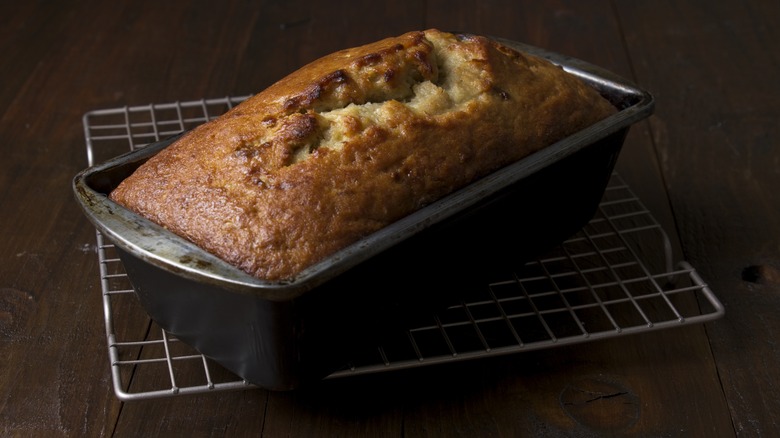How The Great Depression Led To Banana Bread's Rise
In 2020, the BBC reported that banana bread was the number one most-searched-for recipe on the internet. CNN called banana bread the "unofficial snack of the coronavirus pandemic." But foodies have been enjoying soft, warm, comforting banana bread for nearly a century. In 1950, a recipe for banana bread was printed in the Chiquita Banana Recipe Book (via King Arthur Baking). Nowadays, February 23 is celebrated as National Banana Bread Day -– and we understand the hype.
It's a great recipe for entry-level bakers. Julie Ohana, a Michigan-based social worker and the founder of Culinary Art Therapy, told CNN that cooking offers mental health benefits, too. Plus, it's an economical recipe. After all, a basic banana bread recipe only calls for a handful of ingredients. Assuming your pantry is already stocked with baking staples like flour, sugar, and vanilla extract, the remaining basic ingredients don't add up to much — even when you want to add chocolate chips when you're feeling like a loose cannon. In fact, banana bread has a history of thriftiness. Here's how the Great Depression led to banana bread's rise — quick-bread pun intended.
Banana bread is thrifty, filling, and a natural preservative
You might know a friend or neighbor who has a banana tree, but bananas aren't native to the U.S. at all. Today, it's tough to picture a world in which bananas aren't a regular fixture in fruit baskets, hotel continental breakfast buffets, and even the checkout line impulse buy displays at the gas station. But, believe it or not, home cooks didn't begin using bananas until the early 1900s, notes The New York Times, when the advent of refrigeration made transporting bananas from overseas much easier and subsequently more accessible.
During the Great Depression (as per the harrowing namesake), money was super tight, and when money is tight, folks aren't very keen on throwing away food. Per History.com, in 1933, half of the banks in the U.S. had shut down, and an estimated 15 million Americans were out of work. According to "A Square Meal: A Culinary History of the Great Depression" by Andrew Coe and Jane Ziegelman, anything in "loaf form" became wickedly popular during the Great Depression due to the loaf's ability to make food stretch further (via Seconds Food History). Bean loaf, peanut loaf, and even liver loaf were common on the dinner table. When the desperate foodies of the 1930s asked, "How are we going to use up these nearly rotten bananas?" the answer was banana bread. As bananas ripen quickly, this was the perfect way to use less-than-perfect fruit in a meal.

